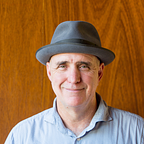3 Things I learned about Finding My Creative Voice.
Do you remember the feeling you had when you raised your hand in class to make a suggestion? Or the very moment when you posted a love letter and the envelope dropped into the postbox? When you pushed the button for your first (and maybe every) social media post? It is the feeling you get when you first show someone a drawing, or share an idea, or build up the courage to suggest your view in a meeting. It is when you hold up both your arms and say, “Look at me!” The feeling is hard to describe, but I think that almost everyone has experienced it. It is not simply fear, though it can be debilitating. The closest word I can come up with is Frisson:
A sudden strong feeling of excitement or fear; a thrill.
Frisson is the feeling that is both a combination of fear and excitement. It is at the pivotal point of every creative process when you put yourself out into the world.
At the moment of pushing the button, opening your sketchbook to someone, stepping up to the mic to make a speech or sing a song, you are in a state of suspended possibility. How is this going to work out? It is at this moment that the emotional state changes and there is a need to dig deep into self-belief.
From that moment, how the world perceives your work is, to a great degree, beyond your control. Of course, you have a better chance of success if you target your concept to your tribe or known market, but ultimately the great unwashed is a fickle mob. You are only as good as your last success.
Once you expose your creative self to the world, ultimately you may have little or no influence on how you will be perceived by it. Now is the moment when you need to dig deep into self-belief, but what if you get a positive, negative or possibly the worst scenario, no response at all? As Oscar Wilde said:
‘There is only one thing in life worse than being talked about, and that is not being talked about.’
The trick is to maintain a healthy dose of self-belief and move forward. Take on board the feedback, but don’t let it define you. Dig deep, even if you get a great response, and ask the question, “Is what I have put out into the world a true reflection of my creative essence?” Now is the time to stand Akimbo to make yourself appear bigger, to show a certain level of arrogance, to say that you are ready for whatever is going to come back to you.
At times, there are successful artists of all types who abandon a hugely successful style that their audience is begging for because their work has moved on. On the flip side, there are endless stories of artists who have pursued work that was appreciated by no-one or a tiny audience, often to become hugely successful after their deaths.
The Australian children’s book author Paul Jennings received a polite rejection for a magazine article he submitted when he was 13 and didn’t have the courage to submit or publish anything else for 25 years.
David Byrne, the frontman of Talking Heads, was rejected from the middle school choir because they said he sang off-key.
Sadly my own experience was closer to Jennings rather than Bynes, and during the dress rehearsal for a school musical, I was singled out and told that I was singing flat, and I had to mine. As a result of that public humiliation, it was decades before I had the courage to try again, sadly with a very similar effect. It took another decade or two before I reached a moment of frisson and set about finding my voice.
But of course, the creative act is not about the feedback, but at the same time, it is all about the feedback. The real question is whether what you put out into the world came from your authentic creative self. If it did, then go forth with confidence, but if not, and you got negative feedback, think about what it is is you are really trying to achieve.
If you want to find your true creative voice.
- Press the button, step up to the mic!
2. Change your mindset once you have but your ideas in the world. Brace yourself and dig deep into self-belief.
3. Review the feedback. Ask yourself the question. Did what I put into the world from my authentic self? Then decide whether to continue or reconsider your next step.
This week The Common Creative podcast with Chris Meredith and myself explores this idea via a story I tell about my journey learning to sing. Listen Here
